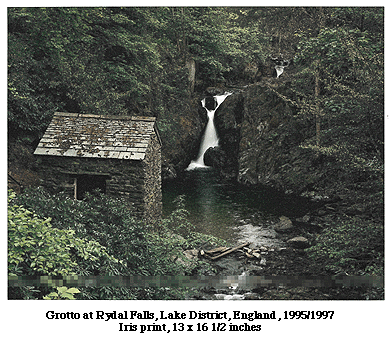John Pfahl
"Permutations on the Picturesque"

John Pfahl
"Permutations on the Picturesque"

In this new series of work, Permutations on the Picturesque, John Pfahl looked to the 18th century British Picturesque movement not only for inspiration, but for precise instruction on the subject, appearance, and point of view of each image. Following the original locations pointed out in the guidebooks of the period, the artist traveled to these locations to create a new series of photographs, and returned with his own variation on the Picturesque landscape. Each of Pfahl's images were scanned into the computer to undergo a series of manipulations to emulate the appearance of a Picturesque period watercolor drawing. The computer allowed the artist to modify each image - removing any distracting branches, misplaced livestock, or to exchange the existing sky for a more agreeable alternative. Within each picture Pfahl has inserted a row of enlarged pixels that span the length of the image. This manipulation draws attention to its computer - assisted construction, and could be considered a type of digital artifact or watermark. It may also be seen as Pfahl's deliberate attempt to disqualify these images from becoming the late 20th century realization of the Picturesque ideal.

In this series Pfahl not only expands on his previous work which merges the idealized landscape image with visual traces of human intervention, but examines the traditions of landscape representation which predate the invention of photography. In looking back to Pfahl's Picture Windows series, the artist's interest in the permanently fixed vista found through the windows of his subjects' homes mirrored the purpose of the viewing stations frequented by the Picturesque tourist. The computer manipulations made to each image in this series share a similar quality to the visual duplicity Pfahl utilized in his early Altered Landscape series. The use of computer manipulation for this particular project adds an additional layer to the convoluted and recursive relationship between technologies, traditions, and the artist's interpretation of nature. In this series, John Pfahl has used the computer as a 20th century equivalent of the Claude Glass(*) to filter his own photographs, thereby creating a new permutation on the Picturesque.
Gary Hesse
Associate Director, Light Work
(*) Claude Glass - a simple optical device whose convex mirror which allowed the user to frame and momentarily fix the undisciplined landscape before them. Many of the estates where these scenes were situated erected permanent viewing stations from which the "perfect" views could be savored through windows such as at West's First Station, or the Grotto at Rydal Falls in Britain's Lake District. Viewing a particular scene through a framed window was a mediated experience which brought the act of viewing the landscape to the level of theater, and many of the writings from the period also used terminology from the theater to describe the Picturesque scene. A series of tinted glass plates were often employed to view a particular setting as it might appear at a different time of day or at another season. Such idealizing techniques were very popular among tourists and artists to conveniently modify the landscape.
"Permutations on the Picturesque" is a portfolio of twenty digitally enhanced Iris prints of images. The portfolio and exhibition was supported by the Light Work Endowment Fund which was established in 1992 to support projects by mid-career artists. This portfolio was printed by Old Town Editions, Alexandria, Virginia.